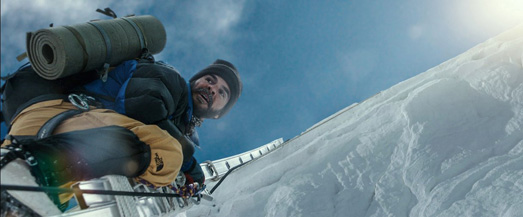Movie Review: Everest
By Ben Gruchow
September 30, 2015
BoxOfficeProphets.com

Is that enough to warrant a recommendation? It depends on how much you’re looking to get from the movie’s story, which obligates itself to the plot points of 1990s disaster films so faithfully that you’d think it was trying to honor its time period. We know the characters involved were real people, and the movie charts the course of their journey accurately, but it’s odd how it feels like it’s also trying to shape them into a cinematic archetype. Is that because it’s merely forcing clichés, or because - to cite one example - expedition leader Rob Hall really did have a pregnant wife at home, and he really did find out that it was going to be a girl the night before he begins his fateful ascent?
We do know that four of Hall’s 11-member expedition did not survive the Everest descent because of two main factors, both of which the movie depicts consequentially: catastrophic lack of planning (there were some 30-odd climbers on that day, one of the few out of the year where summiting Everest isn’t a lethal proposition, where nobody had the foresight to agree on a course of action that would lead everyone to the top and back in enough time) and a freak blizzard that hit the climbers roughly three hours into their descent. None of this is news, and the movie doesn’t treat it as such; we are left with the characterizations of nearly 20 individuals (the climbers, plus the people at Base One, plus assorted family members back home), each of whom are assigned one or two personality traits and guided to filter their actions through those traits.
This is set against the backdrop of an absolutely standard disaster-movie timeline: we get our introductions, a conversation where the nature of the hazard is explained, some character grace notes, early warning signs (in the first of the delays encountered, there were no guide ropes laid across some of the most treacherous terrain of the ascent; this would be irritatingly convenient in a fictional narrative, but it really did happen and was one of the initial events preceding the disaster), and there’s even some moments of ruinous bravado - where the smart thing to do would be turn around and leave and not invite crisis, but the characters are too caught up in making the right symbolic choice to use their brains in the moment. Of course, one of the big symptoms of altitude sickness is impediment to brain function, so this could legitimately be a catalyst for the events of the descent as well.
Some of the people who perished on the mountain are given more focus than others, which either has the effect of or is the reason why their eventual fates are given weightier significance. This makes for effective technique in the moment - and two of these moments, both involving nothing more than the effect of gravity, are probably the most unmanning of any movie this year so far - but it also means that the lives and deaths of real individuals are pushed aside and minimized in favor of theme or narrative for another real individual, and something about that seems a little callous to me.
The movie is at its most effective not when it’s involved in minor character drama or obligatory byplay and setup - again, shades of ’90s disaster films - but in moments like the one on the poster, involving the ladder across a seemingly bottomless chasm in the Khumbu Icefalls. There’s the simple reality of incredible danger and risk, and the people who are willing to experience that danger and risk for whatever reason.
The people at Base One who shepherd these individuals and expeditions acquaint themselves with this danger and risk as readily as the climbers do, except they don’t necessarily know what’s going on or where anyone is moment to moment. A late sequence with two of these individuals, played by Emily Watson and Sam Worthington, confront the nature of their job head-on. These moments may or may not be true to life, but they are authentic, tense, and emotional.
Kormákur uses the tactic of shooting as much of the movie as possible on location (the real Everest Base Camp was used, as well as other locations scattered throughout Nepal), and making the transition to effects gradually. He also doesn’t call attention to anything that would be too obviously set-bound. The end result is a film with an eerily realistic tint to even its most calamitous moments. A climber gingerly traverses a foot-wide path with no ropes over a drop of thousands of feet, and the camera courteously points straight down at him so that we can see the drop whenever we’d care to look. Is it CGI? Matte work? I didn’t care; I got vertigo. Other moments are similarly dizzying, and this is not a movie for those with a fear of heights.
I liked the movie, but I have a feeling that I liked it more because it doesn’t really do anything wrong and because it frames a tragedy with responsibility and clarity than because it particularly does anything right. It certainly doesn’t do anything outside the structural or stylistic or characterization realm of a well-made disaster film, and because of that it achieves a certain degree of effectiveness and respect. You will not miss any crucial aspect of the event or the effect on the people involved if you read about it, so the major reason to see the movie would be the visceral sequences on Everest itself. See it in IMAX, if you can.